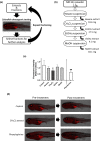Zebrafish obesogenic test identifies anti-adipogenic fraction in Moringa oreifera leaf extracts
- PMID: 35432980
- PMCID: PMC9007296
- DOI: 10.1002/fsn3.2758
Zebrafish obesogenic test identifies anti-adipogenic fraction in Moringa oreifera leaf extracts
Abstract
The zebrafish obesogenic test (ZOT) is a powerful tool for identifying anti-adipogenic compounds for in vivo screening. In our previous study, we found that Moringa oleifera (MO) leaf powder suppressed the accumulation of visceral adipose tissue (VAT) in ZOT. MO demonstrates a wide range of pharmacological effects; however, little is known about its functional constituents. To identify the anti-adipogenic components of MO leaves, we prepared extracts using different extraction methods and tested the obtained extracts and fractions using ZOT. We found that the dichloromethane extract and its hexane:EtOAc = 8:2 fraction reduced VAT accumulation in young zebrafish fed a high-fat diet. We also performed gene expression analysis in the zebrafish VAT and found that CCAAT/enhancer-binding protein beta and CCAAT/enhancer-binding protein delta (associated with early stages of adipogenesis) gene expression was downregulated after fraction 2 administration. We identified a new MO fraction that suppressed VAT accumulation by inhibiting early adipogenesis using the ZOT. Phenotype-driven zebrafish screening is a reasonable strategy for identifying bioactive components in natural products.
Keywords: diabetes; dyslipidemia; herbal medicine; natural products; visceral obesity.
© 2022 The Authors. Food Science & Nutrition published by Wiley Periodicals LLC.
Conflict of interest statement
Youngil Kim, Djong‐Chi Chu, and Lekh Raj Juneja are employees of Rohto Pharmaceutical Co., Ltd.. The other authors declare no competing interests.
Figures



Similar articles
-
Anti-Obesity Natural Products Tested in Juvenile Zebrafish Obesogenic Tests and Mouse 3T3-L1 Adipogenesis Assays.Molecules. 2020 Dec 10;25(24):5840. doi: 10.3390/molecules25245840. Molecules. 2020. PMID: 33322023 Free PMC article.
-
Anti-Obesity Potential of Ponciri Fructus: Effects of Extracts, Fractions and Compounds on Adipogenesis in 3T3-L1 Preadipocytes.Molecules. 2022 Jan 20;27(3):676. doi: 10.3390/molecules27030676. Molecules. 2022. PMID: 35163941 Free PMC article.
-
Moringa oleifera Leaf Petroleum Ether Extract Inhibits Lipogenesis by Activating the AMPK Signaling Pathway.Front Pharmacol. 2018 Dec 18;9:1447. doi: 10.3389/fphar.2018.01447. eCollection 2018. Front Pharmacol. 2018. PMID: 30618744 Free PMC article.
-
Molecular mechanism of down-regulating adipogenic transcription factors in 3T3-L1 adipocyte cells by bioactive anti-adipogenic compounds.Mol Biol Rep. 2021 Jan;48(1):743-761. doi: 10.1007/s11033-020-06036-8. Epub 2020 Dec 4. Mol Biol Rep. 2021. PMID: 33275195 Review.
-
Molecular Regulation of Adipogenesis and Potential Anti-Adipogenic Bioactive Molecules.Int J Mol Sci. 2016 Jan 19;17(1):124. doi: 10.3390/ijms17010124. Int J Mol Sci. 2016. PMID: 26797605 Free PMC article. Review.
Cited by
-
An optimized zebrafish obesogenic test protocol with an artificial intelligence-based analysis software for screening obesogens and anti-obesogens.Biol Methods Protoc. 2025 Jul 1;10(1):bpaf052. doi: 10.1093/biomethods/bpaf052. eCollection 2025. Biol Methods Protoc. 2025. PMID: 40799311 Free PMC article.
References
-
- Ahmad, J. , Khan, I. , Johnson, S. K. , Alam, I. , & Din, Z. U. (2018). Effect of incorporating stevia and Moringa in cookies on postprandial glycemia, appetite, palatability, and gastrointestinal well‐being. Journal of the American College of Nutrition, 37(2), 133–139. 10.1080/07315724.2017.1372821 - DOI - PubMed
-
- Almatrafi, M. M. , Vergara‐Jimenez, M. , Murillo, A. G. , Norris, G. H. , Blesso, C. N. , & Fernandez, M. L. (2017). Moringa leaves prevent hepatic lipid accumulation and inflammation in guinea pigs by reducing the expression of genes involved in lipid metabolism. International Journal of Molecular Sciences, 18(7), 1330. 10.3390/ijms18071330 - DOI - PMC - PubMed
-
- Balakrishnan, B. B. , Krishnasamy, K. , & Choi, K. C. (2018). Moringa concanensis Nimmo ameliorates hyperglycemia in 3T3‐L1 adipocytes by upregulating PPAR‐γ, C/EBP‐α via Akt signaling pathway and STZ‐induced diabetic rats. Biomedicine and Pharmacotherapy, 103, 719–728. 10.1016/j.biopha.2018.04.047 - DOI - PubMed
-
- Busquet, F. , Strecker, R. , Rawlings, J. M. , Belanger, S. E. , Braunbeck, T. , Carr, G. J. , Cenijn, P. , Fochtman, P. , Gourmelon, A. , Hübler, N. , Kleensang, A. , Knöbel, M. , Kussatz, C. , Legler, J. , Lillicrap, A. , Martínez‐Jerónimo, F. , Polleichtner, C. , Rzodeczko, H. , Salinas, E. , … Halder, M. (2014). OECD validation study to assess intra‐ and inter‐laboratory reproducibility of the zebrafish embryo toxicity test for acute aquatic toxicity testing. Regulatory Toxicology and Pharmacology, 69(3), 496–511. 10.1016/j.yrtph.2014.05.018 - DOI - PubMed
LinkOut - more resources
Full Text Sources
Molecular Biology Databases

